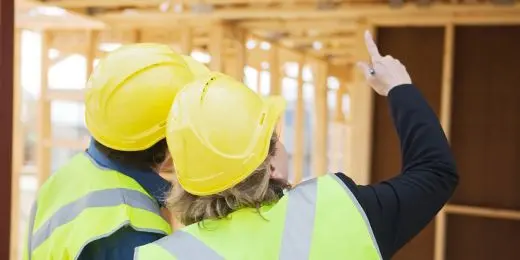What is Construction Safety Training?
Construction safety training is a comprehensive program designed to educate all workers in a construction site about the potential hazards and risks in their environment, the most effective mitigation strategies, and how to respond to emergencies. The main goal of this type of training is to promote a culture of safety in the workplace, preventing accidents, injuries, and fatalities in the process, ensuring compliance with regulations, and improving overall productivity.
Benefits
According to the BLS (Bureau of Labor Statistics), almost half of all falls, slips, and trips in 2021 occurred in the construction industry. Unfortunately, the numbers do not seem to decrease, meaning there is more to do to prop up safety in this high-risk environment.
By increasing awareness through regular construction site safety training, workers can protect themselves and others. Here are some specifics:
Increased knowledge of safety hazards
Construction workers face assorted risks on site. Aside from falls and trips, they could get struck by objects, electrocuted, and caught between objects like heavy machinery.
Doubling down on these dangers through comprehensive onboarding and daily toolbox meetings helps workers be more alert while they work.
Improve your EHS Management
Cultivate a safe working environment and streamline compliance with our EHS solutions.
Explore nowEnsured compliance with regulations
This industry is highly regulated because, as explained above, it comes with inherent risks and hazards. Aside from the fact that training provides workers with the knowledge and skills for proper ladder use, scaffolding, and fall protection, they are also assured of compliance since these are also mandated by agencies like:
- Occupational Safety and Health Administration (OSHA) in the United States;
- Safe Work Australia; and
- Health and Safety Executive (HSE) in the United Kingdom.
Enhanced productivity and revenues
Workers function better when they feel more secure in their workplace. They have more confidence, motivation, and efficiency.
Aside from the fact that productive workers benefit the company’s bottom line because they get to finish their jobs at high quality and on time, the company does not have to spend money on hospitalizations, insurance costs, and possible fines.
Key Components
There are numerous topics covered in construction safety training. However, managers prioritize the ones listed below because these address the most common causes of incidents at the work site.
Hazard Identification and Risk Assessment
Recognizing there are dangers in the surroundings is essential to protect oneself from them, proactively mitigate risks, and minimize the likelihood of accidents. Here are some of the most common causes of injuries in construction sites, named the four focus by OSHA:
- Slips, Trips, and Falls – This is the number one cause of accidents in the industry because building structures requires working at heights. Falls usually happen when ladders and scaffoldings are not properly set up, while slips and trips occur when surfaces are not kept dry, clear, flat, or clean.
- Struck by Objects – This is the second most common injury in the sector, causing over 14,000 injuries in 2020 and $1.4 billion in compensation. Falling objects (e.g., tools, hard hats, equipment parts) from roofs and cranes pose the highest risk, causing lacerations, broken bones, and even traumatic brain injuries.
- Electrocutions – According to the CDC, almost 60% of all electrocutions result in direct contact with electricity from insufficient insulation, damaged equipment, and improper use of extension cords.
- Caught In or Between Objects – With numerous heavy machinery and large building materials on site, getting pinched, squeezed, and crushed in or between two moving parts is quite common. When workers understand how these could happen, they can adequately protect themselves.
Proper Use of PPE (Personal Protective Equipment)
Equipping workers with the appropriate PPE is non-negotiable in this sector. Based on OSHA statistics, 84% of 1,000 workers suffer fatal head injuries because they fail to wear a safety helmet. Aside from providing this equipment, workers should also be taught the following:
- PPE requirements (standards and levels)
- Safety walk or thorough inspection before use
- Proper and constant use while at work
- Regular maintenance
Equipment Operation and Handling
Most construction machinery requires precise operation, taught through classroom sessions and hands-on instruction. When workers understand the nuances of handling this equipment, emphasizing safety protocols, proper techniques, and regular maintenance, they can prevent accidents. Here are some topics to include in the training program:
- Safe mounting and dismounting
- Site preparation with proper equipment ingress and egress
- Lifting loads and load capacity
- Lockout/tagout (LOTO) procedures
- Inspection before and after use
- Regular maintenance
Emergency Procedures
This component involves educating workers about the necessary steps to take during emergencies, whether it involves an injured worker or more critical situations like a fire outbreak. This enables workers to respond to any emergency effectively, minimizing injuries and saving lives. Topics for discussion should include the following
- First aid and location for first aid sites
- Evacuation procedures with exit route assignments and shelter sites
- Standard operating procedures (SOP) for reporting
- Roles and responsibilities of designated emergency managers
Other topics that may be included in construction safety training programs are ergonomics, heat safety, excavation and trenching, and dealing with special hazards (e.g., chemical spills, toxic wastes, radioactive substances). It is up to safety managers and trainers to organize the information and schedule the sessions for specific teams or individuals.
Emerging Trends in Construction Safety Training
Safety training is not just a one-time affair. This ongoing process necessitates daily reminders, refreshers, and updates. Often, there are new standards and practices that should be learned and innovative ways to deliver them. Here are some of which all safety and training managers should be aware of:
Integrating Technology in Learning
Learning Management Systems (LMS) are incredibly beneficial to any company from any industry today. The platform can help organizations meet their training goals safely without disrupting everyday workflows. Here are some features that will be helpful in this industry:
- Mobile learning makes it easier for workers to access materials on the go.
- Online tests are available for employees, helping them review for required certifications.
- Virtual and augmented reality create immersive training experiences, allowing workers to practice safety procedures in a controlled environment.
Fully prepare your workers for the job they are about to do by providing them with appropriate skills and knowledge with the help of online platforms like SafetyCulture’s Training. With this digital platform, you can analyze skill gaps, create personalized modules for specific teams, track their progress, and monitor their performance on-site.
Behavior-Based Safety
Behavior-Based Safety (BBS) is a process that focuses on people’s behavior and how that impacts safety.
When creating a training program, companies should have a holistic understanding of their workers’ attention and actions in a particular working environment and their reasons for taking risks (e.g., conscious choices, habits, and obstacles). Positive reinforcement and peer-to-peer mentoring should also be encouraged.
Construction Sustainability
Sustainable construction is not just about using renewable and recyclable resources for building. One good example of this is PtD (Prevention through Design), a process aimed at creating green designs that prioritize the safety of the workers and the end users.
Companies should not ignore innovations like these and bring them to the fore by including them in their training programs.




